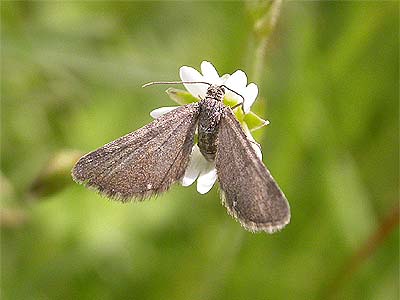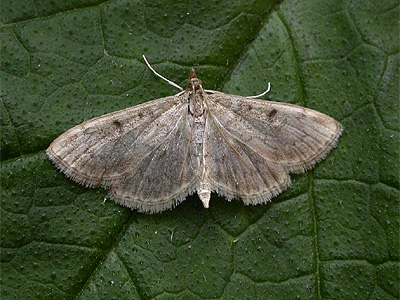

| Marsh Pug and Phlyctaenia perlucidalis - two important moths at Eakring |
| The discovery
and trapping of two rare Nottinghamshire moths in the
area during 2003, represent an important find on both a
local and county scale. A recent change in the national
status of one of these, has since seen it's occurrence
here take on an even greater significance.
The Marsh Pug is now categorised as a Grade 1 species in Nottinghamshire. The fact that it has been discovered at one fragile site on the outskirts of Eakring village, may possibly enable that site to attain SINC (Sites of Importance for Nature Conservation) status. There are still only a small number of records concerning Phlyctaenia perlucidalis in Nottinghamshire and the single adults which were caught at Eakring Meadows and then later at Eakring Flash, also represented a significant discovery. |
||
| ...... | ||
 |
Marsh
Pug Eupithecia pygmaeata This is an inconspicuous species, small and rather bland. Even by Pug standards, it has few distinguishing markings - the most prominent being the white spots on the forewings Discovery at Eakring in 2003A major clue to realising my initial (suspected) identifcation, were the moth's general habits noted in the field. This is the only Pug species we have found actively flying during daylight. Although this was initially thought to be due to disturbance from grasses whilst resting, confirmation occured a short while later when I observed a second adult flying low amongst vegetation. Most of the adults observed in the field were females and on numerous occasions, these were typically flying very low and searching for the flowers of Field Mouse-ear (Cerastium arvense) where eggs were noted being laid inside the flower heads. |
|
| ...... | ||
 |
Marsh Pugs were first
recorded here from an area of established meadowland on
Red Hill (late May 2003) before also being found at
Eakring Meadows, where the photographs of an ovipositing
female were taken - then later at Oil Bore Holes in
Eakring village. In 2004, another small population was
discovered along Mill Lane, on the outskirts of Eakring
village. Nottinghamshire status The Marsh Pug was formerly ascribed a Grade 2 listing in the county and was immediately deemed to be one of the most important finds made during 2003. However, the Marsh Pug has recently been categorised as a Grade 1 Nottinghamshire species - following a change in its National Status from being Local to Nationally Notable. It's small size renders it quite inconspicuous and could be quite easily overlooked in other suitable habitats. The only other currently known site in Nottinghamshire are the Carr-lands around Misterton in the very north of the county. |
|
| ...... | ||
| National
status of the Marsh Pug In his book Moths of the British Isles, Skinner describes Marsh Pug as being very local and rather uncommon - occurring in widely scattered localities from Bedfordshire and Warwickshire, northwards to Cumbria and Yorkshire, North and South Wales, Isle of Man, Scotland including Orkney, and western and northern Ireland. |
||
| Phlyctaenia
perlucidalis The indivdual pictured (below right) was netted late evening, whilst flying low over the western-most meadow at Eakring Meadows NR on May 29th. Evading capture at the initial attempt, the moth promptly fell to the ground and disappeared in typical fashion, reminiscent of many species. Fortunately I persevered and managed to obtain the moth for photographing - at the time not knowing it's identity or rarity status. It was released the following evening at the original location of capture. Surprisingly a second adult was netted after being flushed from vegetation at Eakring Flash on June 21st. |
||
| ...... | ||
| Nottinghamshire
status The current status of P. perlucidalis in Nottinghamshire is under investigation and the only direct information I have at the moment comes from Dr Sheila Wright at the Nottingham Biological and Geographical Records Centre at Wollaton Hall, stating the first occurrence of P. perlucidalis as coming from Newstead Abbey in 1991. There have been a few more recent records during the interim period, but the record here, remains a significant one. National status and history of P. perlucidalis The species was first recorded from Woodwalton Fen in 1951. Further records then occurring from fens in both Huntingdonshire and Cambridgeshire, with others found along south-east coastal areas. It has however, been recorded as far north as Rudston in south-east Yorkshire in 1983 (Agassiz, 1984) |
 |
|
| In the
neighbouring county of Leicestershire, this moth has been
recorded from mainly around reedbed areas in south-west
Leics and Rutland. Other potential sites in north
Leicestershire (especially around the Trent Valley area)
have not been well enough covered to determine if the
species is there. (infomation provided by
Mark Skevington) References :- British Pyralid Moths (Goater) 1986; Moths of the British Isles (Skinner) 1998. British Wildlife species reports: Moths (Waring) August 2003. |
||